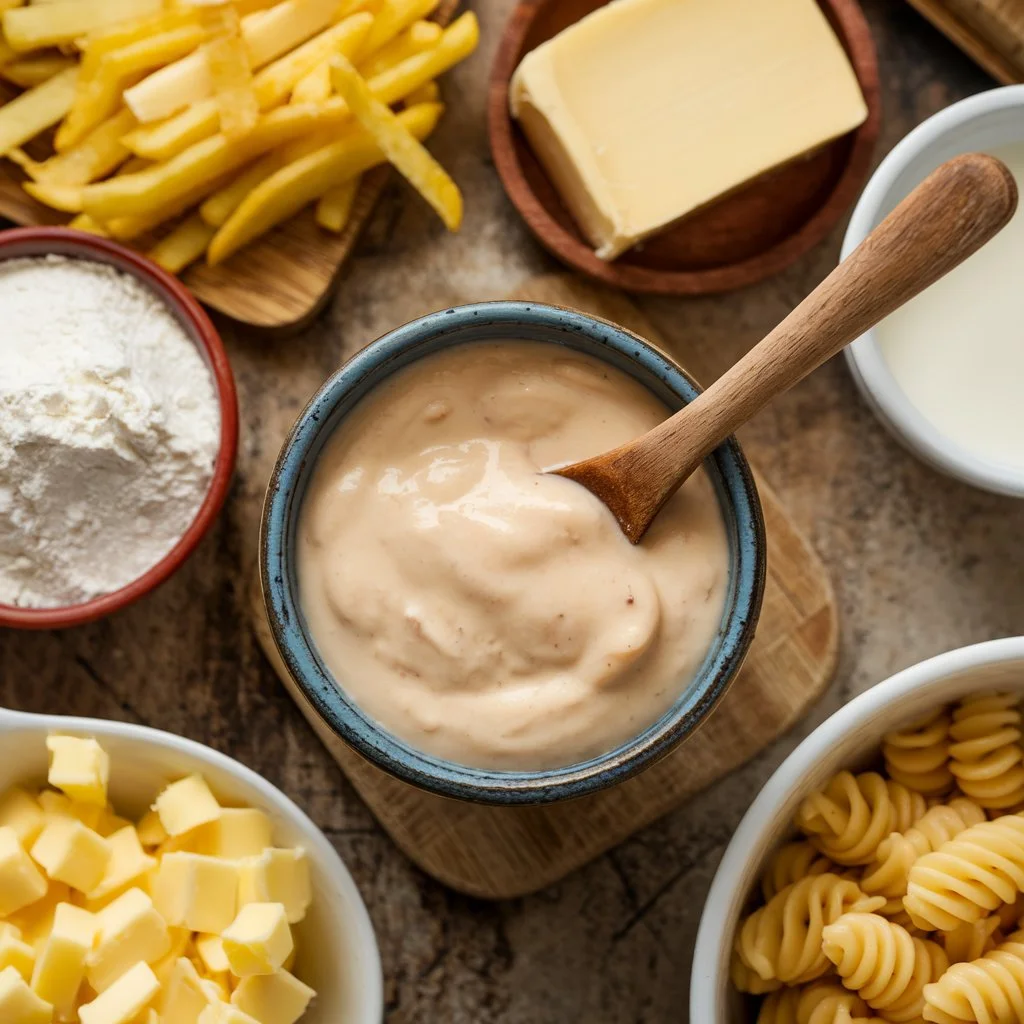There’s something undeniably comforting about a homemade cheese sauce—its creamy richness has the power to transform even the simplest meal into something extraordinary. Whether you’re pouring it over crispy fries, mixing it into a comforting bowl of pasta, or using it as a dip for vegetables, the versatility of cheese sauce is boundless. But beyond its mouthwatering taste, making your own cheese sauce from scratch brings a sense of satisfaction and pride that store-bought versions simply can’t match.
In this guide, you’ll learn how to craft a creamy, smooth, and flavorful homemade cheese sauce that’ll quickly become a staple in your kitchen. Whether you’re a seasoned cook or just starting out, this step-by-step process will give you the tools to create the perfect cheese sauce every time. So grab your whisk and let’s get started!
Table of Contents
What is Homemade Cheese Sauce?
Homemade cheese sauce is a creamy, cheesy concoction made by combining a few simple ingredients like butter, flour, milk, and cheese. It’s essentially a basic béchamel sauce (the foundation of many creamy sauces) that’s enhanced with cheese for flavor. Unlike store-bought varieties, homemade cheese sauce allows you to control every aspect—texture, flavor, and ingredients.
By making your own cheese sauce, you’re ensuring that it’s fresh, preservative-free, and customizable. With just a few pantry staples, you can whip up a sauce that complements your meals perfectly, whether you’re using cheddar, Gruyère, mozzarella, or a blend of different cheeses.
Why Choose Homemade Over Store-Bought Cheese Sauce?
While pre-made cheese sauces are convenient, they often come with a long list of preservatives and artificial ingredients that detract from the true flavor. Here’s why making your own cheese sauce is worth the effort:
- Taste and Quality: Homemade cheese sauce has a fresher, more vibrant flavor. With store-bought versions, you may notice a lack of depth or a too-thick consistency.
- Healthier Option: Store-bought sauces may contain added sugars, unhealthy fats, or artificial flavorings. Making your cheese sauce from scratch means you can use wholesome ingredients, like high-quality cheese, real butter, and fresh milk.
- Customization: You can tailor your cheese sauce to your specific preferences. Want a spicier sauce? Add some cayenne pepper or hot sauce. Prefer a more savory, umami flavor? Try adding garlic powder or mustard.
Ingredients for Homemade Cheese Sauce
The beauty of homemade cheese sauce lies in its simplicity. You don’t need a long list of complicated ingredients—just a few basics, and you’re good to go. Let’s take a look at what you’ll need.
Basic Ingredients You’ll Need
Here are the essential ingredients for a smooth, creamy cheese sauce:
| Ingredient | Quantity |
|---|---|
| Butter | 2 tbsp |
| All-purpose flour | 2 tbsp |
| Whole milk | 1 cup |
| Shredded cheese | 1 ½ cups |
| Salt and pepper | To taste |
Optional Add-ins for Extra Flavor
While the basic recipe is delicious on its own, you can always add extra ingredients to take your cheese sauce to the next level. Here are some ideas:
- Mustard powder: Adds a subtle tang that balances the richness.
- Garlic powder: For a savory depth.
- Cayenne pepper or paprika: Adds a hint of spice and smokiness.
- Worcestershire sauce: A few drops can provide a nice umami kick.
- Fresh herbs: Try chives, thyme, or parsley to garnish your sauce and enhance its flavor.
Choosing the Right Cheese for Your Sauce
The type of cheese you use can dramatically affect the flavor and texture of your cheese sauce. Here are a few options that work particularly well:
- Cheddar: A classic choice for cheese sauce. It melts well and has a sharp flavor that pairs beautifully with many dishes.
- Gruyère: If you’re looking for a smoother, more complex flavor, Gruyère is a great choice.
- Mozzarella: Ideal for a mild, creamy sauce that melts smoothly.
- Monterey Jack: Offers a smooth texture and mild flavor.
You can even experiment with a combination of cheeses to find your perfect flavor profile. Try combining cheddar with Gruyère for a rich, smooth sauce with depth, or blend cheddar with mozzarella for a stretchy, creamy texture.
Step-by-Step Guide to Making Homemade Cheese Sauce
Making cheese sauce is simple, but there are a few important steps to ensure you end up with a silky, creamy result. Let’s walk through the process.
Step 1: Make the Roux
A roux is a mixture of fat (usually butter) and flour that thickens sauces. It’s essential for creating a smooth base for your cheese sauce.
- Start by melting 2 tablespoons of butter in a medium-sized saucepan over medium heat.
- Once the butter has melted, add 2 tablespoons of all-purpose flour.
- Whisk the mixture constantly for about 1-2 minutes to cook the flour. This step prevents the flour from tasting raw.
Step 2: Add the Milk
Now it’s time to incorporate the milk. The key here is to add it slowly and whisk constantly to avoid lumps.
- Gradually pour in 1 cup of whole milk, a little at a time, while continuing to whisk the mixture.
- Keep whisking until the sauce thickens to your desired consistency. If it’s too thick, you can add a little more milk to thin it out.
Step 3: Melt in the Cheese
Once your milk mixture is smooth and thickened, it’s time to add the cheese.
- Reduce the heat to low to prevent the cheese from overheating and separating.
- Slowly add 1 ½ cups of shredded cheese into the sauce, stirring constantly until fully melted and smooth.
- Taste the sauce and add salt and pepper as needed.
Step 4: Seasoning Your Sauce
Once the cheese has melted into the sauce, it’s time to season it to perfection. Add salt and freshly ground black pepper to taste. If you’re feeling adventurous, now’s the time to add any optional spices or flavorings from the list above.
Tips and Tricks for Perfecting Homemade Cheese Sauce
Homemade cheese sauce is straightforward, but there are a few tips to ensure it turns out perfectly every time.


Common Mistakes to Avoid
- Overheating the sauce: High heat can cause the cheese to separate and become greasy. Always cook your sauce on low heat.
- Lumpy sauce: This typically happens when you add the milk too quickly or don’t whisk enough. To avoid lumps, add the milk gradually and whisk continuously.
- Using the wrong cheese: Some cheeses, like pre-shredded varieties, contain additives that prevent them from melting smoothly. Stick to fresh, high-quality cheese for the best results.
How to Make Cheese Sauce Ahead of Time
If you want to prepare your cheese sauce in advance, it’s easy to store and reheat. Here’s how:
- Storage: Allow the cheese sauce to cool to room temperature before transferring it to an airtight container. Store it in the fridge for up to 3-4 days.
- Reheating: To reheat, warm the sauce over low heat, stirring frequently. If the sauce has thickened too much, add a little milk to reach the desired consistency.
How to Make Cheese Sauce Thicker or Thinner
If you want to adjust the consistency of your cheese sauce, here are some tips:
- Thicker Sauce: Add more cheese, or let it cook for a few more minutes until it thickens.
- Thinner Sauce: Gradually add more milk until you reach your desired consistency.
Creative Ways to Use Homemade Cheese Sauce
Now that you’ve perfected your homemade cheese sauce, let’s explore some delicious ways to use it.
Classic Comfort Foods
- Macaroni and Cheese: The ultimate classic! Stir your cheese sauce into cooked macaroni for a rich, comforting dish.
- Cheese Fries: Drizzle your cheese sauce over crispy fries for a savory snack.
- Nachos: Pour the cheese sauce over tortilla chips, and add your favorite toppings like jalapeños, sour cream, and guacamole.
Unexpected Uses for Cheese Sauce
- Vegetables: Cheese sauce can make even the most mundane vegetables taste amazing. Try it over steamed broccoli, roasted cauliflower, or carrots.
- Sandwiches: Add cheese sauce to your grilled cheese sandwich or pour it over a chicken sandwich for extra flavor.
- Meat Dishes: Cheese sauce can also pair wonderfully with grilled or roasted meats like chicken or steak.
Pairing Cheese Sauce with Drinks
To balance out the richness of cheese sauce, try pairing it with beverages that complement its flavor. A crisp, refreshing drink like a cold beer or a fruity white wine can work wonders to cut through the creaminess.
Conclusion
Homemade cheese sauce is the perfect addition to many dishes, bringing comfort and flavor to any meal. Whether you’re using it in macaroni and cheese, over fries, or as a dip, making your own sauce from scratch allows you to customize the flavor and ensure its freshness. By following the simple steps outlined in this guide, you can create a creamy, smooth, and rich cheese sauce that will elevate your meals and impress your friends and family.
Ready to make your own homemade cheese sauce? Grab your ingredients, follow the steps, and start experimenting with different cheese blends and flavors. Don’t forget to share your creations with us—whether it’s a cheesy pasta dish or a bowl of nachos. Happy cooking!

